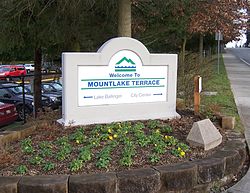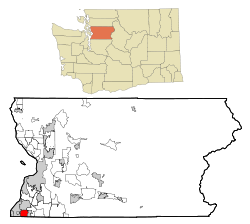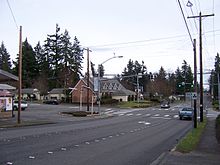- Mountlake Terrace, Washington
-
Mountlake Terrace, Washington — City — Mountlake Terrace Welcome sign Location of Mountlake Terrace, Washington Coordinates: 47°47′27″N 122°18′24″W / 47.79083°N 122.30667°WCoordinates: 47°47′27″N 122°18′24″W / 47.79083°N 122.30667°W Country United States State Washington County Snohomish Government - Type mayor/city council - Mayor Area - Total 4.1 sq mi (10.7 km2) - Land 4.0 sq mi (10.5 km2) - Water 0.1 sq mi (0.3 km2) Elevation 456 ft (139 m) Population (2010) - Total 19,909 - Density 5,036.7/sq mi (1,946.0/km2) Time zone Pacific Time Zone (UTC-8) - Summer (DST) PDT (UTC-7) ZIP code 98043 Area code(s) 425 FIPS code 53-47490[1] GNIS feature ID 1512488[2] Website http://www.ci.mountlake-terrace.wa.us/ Mountlake Terrace is a city in Snohomish County, Washington, United States. It lies east of Edmonds, Washington, south of Lynnwood, Washington, and west of Brier, Washington. Its southern boundary runs along the King County line. Interstate 5 runs north-south through the city, and services the city via three exits. The population was 19,909 at the 2010 United States Census.
Contents
History
In the nineteenth century the Mountlake Terrace site was thickly forested. Natives criss-crossed the area to hunt, gather berries and dig roots. The thick forested land was obtained by the Puget Mill Company in 1862. By 1900 most of the land in south Snohomish County had been logged off, so Pope & Talbot Co. (the successor entity to the Puget Mill Co.), subdivided it into 10-acre (40,470 m²) "chicken ranches". This effort was moderately successful (the larger area was known as Alderwood Manor during this time), as a few people moved into the area to raise chicken, mink and chinchilla. An interurban rail line between Tacoma, Washington and Everett, Washington (1910) allowed easier access. Many of those small farms failed during the Great Depression, and the railroad was abandoned in 1939.
A portion of the area was used by the government during World War II as a landing field. At the end of the war the government ceased operation, and in 1949 Albert LaPierre and Jack Peterson[3] bought the abandoned airstrip and began filling it with modest cinder-block houses. They named their development Mountlake Terrace because from some parts of the property they could see both Mount Rainier and Lake Washington, and the old runway looked a little like a terrace.
The city is born
In 1954 over 5,000 people lived in the area between 244th and 216th Streets SW, and 48th and 68th Avenues W. The existing infrastructure was overwhelmed by this unplanned growth; people waited a year for a party-line telephone; streets were unpaved; house sanitation was provided by individual septic systems. The nearest police department was in Everett, 15 miles away. One frustrated resident, Patrick McMahan, organized the Mountlake Terrace Study Committee, which led a campaign to incorporate the community. An election (23 November 1954) supported incorporation, 517 to 483. Voters chose a five-person city council at the same election. The council had its first meeting on November 24 and selected Gilbert "Gil" Geiser (1919–1997), a 35-year-old hardware store owner, as Mountlake Terrace's first mayor. Geiser had to lend the new city $5 so the incorporation papers could be filed. With the filing, on November 29, Mountlake Terrace officially became a third-class city.
The new city grows
Mountlake Terrace's population doubled between 1950 and 1960 and then nearly doubled again by 1970. Small businesses flourished in two strip-mall-type shopping centers in the middle of the area, on land provided by the developers. The developers also donated land for several churches, including the parish of St. Pius X, which celebrated its first mass on 22 June 1955. The John Fluke Corporation moved its electronics center from Seattle to Mountlake Terrace in 1959. In 1961 a bond issue was approved in a special election; it was used to build a City Hall.
Growth slows
The city had been first envisioned as an automobile-based bedroom community, but subsequent leaders began to envision it as a "stand-alone" development with a viable downtown area. This effort was aided by the arrival of Fluke and the construction of the two strip malls and the City Hall. However, the 1980s brought a standstill. The Boeing Company suffered a significant business downturn (about 75% of the Everett workers lost their jobs in that decade); Lynnwood opened a large mall (Alderwood Mall) which drew much of the area's business away from downtown; and in 1990 two arson-caused fires in the city center caused significant destruction.[4] In 1981 Fluke moved its facility to Everett. The 1980 census showed that Mountlake Terrace's population had dropped by almost 5 percent in 10 years. The city budget was trimmed and trimmed again and even so, Mountlake Terrace entered 1989 with a $1.3 million deficit.
Recent history
The mid-2000s saw new construction on 56th Avenue, and in 2006 the city created a plan to revitalize downtown and encourage economic activity.[5][6] As of 2006 the town's largest employer was Premera Blue Cross, which employed some 2,400 people.
A city-center plan adopted in February 2007 allows mixed-use buildings of up to seven stories in the central block and up to five stories in surrounding blocks. The previous limit was three stories.
Geography
Mountlake Terrace is located at 47°47′27″N 122°18′24″W / 47.790969°N 122.306636°W (47.790969, -122.306636).[7] The city's elevation above sea level ranges between 262 and 530 feet (160 m), with an average altitude of 440 feet (130 m).
According to the United States Census Bureau, the city has a total area of 4.2 square miles (10.7 km2), of which, 4.0 square miles (10.5 km2) is land and 0.1 square miles (0.3 km2) is water. The total area is 2.65 % water.
The southwestern portion of the city includes Lake Ballinger Park, which offers access to Lake Ballinger and contains a boat launch and a fishing pier. The lake itself is located partially in Mountlake Terrace and partially in neighboring Edmonds.[8]
Demographics
Historical populations Census Pop. %± 1960 9,122 — 1970 16,600 82.0% 1980 16,534 −0.4% 1990 19,320 16.9% 2000 20,362 5.4% 2010 19,909 −2.2% As of the 2000 census[1], there were 20,362 people, 7,962 households, and 5,016 families residing in the city. The population density was 5,036.7 people per square mile (1,946.0/km2). There were 8,217 housing units at an average density of 2,032.6 per square mile (785.3/km2). The racial makeup of the city was 77.70% White, 2.52% African-American, 1.08% Native American, 10.64% Asian, 0.58% Pacific Islander, 2.61% from other races, and 4.87% from two or more races. Hispanic or Latino of any race were 5.65% of the population.
There were 7,962 households out of which 32.8% had children under the age of 18 living with them, 46.2% were married couples living together, 11.8% had a female householder with no husband present, and 37.0% were non-families. 26.2% of all households were made up of individuals and 6.4% had someone living alone who was 65 years of age or older. The average household size was 2.54 and the average family size was 3.11.
In the city the age distribution of the population shows 25.3% under the age of 18, 9.8% from 18 to 24, 35.6% from 25 to 44, 20.2% from 45 to 64, and 9.2% who were 65 years of age or older. The median age was 34 years. For every 100 females there were 98.0 males. For every 100 females age 18 and over, there were 95.6 males.
The median income for a household in the city was $47,238, and the median income for a family was $52,117. Males had a median income of $37,421 versus $28,796 for females. The per capita income for the city was $21,566. About 5.8% of families and 8.0% of the population were below the poverty line, including 11.3% of those under the age of 18 and 7.6% of those aged 65 and older.
See also
References
- ^ a b "American FactFinder". United States Census Bureau. http://factfinder.census.gov. Retrieved 2008-01-31.
- ^ "US Board on Geographic Names". United States Geological Survey. 2007-10-25. http://geonames.usgs.gov. Retrieved 2008-01-31.
- ^ Jack Peterson (1904-1996, Saskatchewan) arrived in Seattle in the late 1930s. Albert L. LaPierre (1907-1989) was an imaginative developer and organizer. In 1949 they bought land north of 244th Street SW and east of I-5, named it, platted it, and began building two-bedroom houses on (20'x30') concrete slabs. The houses were built on a type of assembly line; interior painting and landscaping were left to the purchasers. With demand for housing soaring, the houses sold faster than they could be built. Peterson-LaPierre bought more land and built larger houses, but kept their prices reasonable
- ^ A local resident, James Schmitt, confessed to setting a total of 13 fires, two in the 56th Avenue/232nd Street area. West Plaza was out of business for 20 months; East Plaza was permanently shut down, replaced with a gymnastics center.
- ^ "Mountlake Terrace History". City of Mountlake Terrace. http://www.ci.mountlake-terrace.wa.us/forVisitors/communityProfile/history.htm?B.
- ^ The council approved design standards requiring that new developments be built with wide sidewalks, lots of windows, awnings, and interesting architectural details.
- ^ "US Gazetteer files: 2010, 2000, and 1990". United States Census Bureau. 2011-02-12. http://www.census.gov/geo/www/gazetteer/gazette.html. Retrieved 2011-04-23.
- ^ "Lake Ballinger". Surface Water Management Division. Snohomish County Public Works. http://www1.co.snohomish.wa.us/Departments/Public_Works/Divisions/SWM/Work_Areas/Water_Quality/Lakes/LakeBallinger.htm. Retrieved 2010-12-16.
External links
- City of Mountlake Terrace
- Cassandra Tate (April 06, 2008), Mountlake Terrace -- Thumbnail History, HistoryLink, http://www.historylink.org/index.cfm?DisplayPage=output.cfm&file_id=8576
 State of Washington
State of WashingtonOlympia (capital) Topics State government | Cities | Towns | Congressional delegation | City governments | Governors | History | Geography | People | Legislative initiatives | Popular initiatives | Legislature | Music | Parks | Highways | Symbols | Visitor attractions
Society Demographics · Economy · Education · Politics
Regions Larger cities and
metropolitan areasSeattle | Seattle metropolitan area | Spokane | Tacoma | Tri-Cities | Vancouver | Bellevue | Everett | Yakima
Smaller cities Aberdeen | Anacortes | Arlington | Auburn | Bainbridge Island | Battle Ground | Bellingham | Bonney Lake | Bothell | Bremerton | Burien | Camas | Centralia | Cheney | Cle Elum | Coupeville | Covington | Des Moines | East Wenatchee | Edmonds | Ellensburg | Enumclaw | Federal Way | Fort Lewis | Grandview | Hoquiam | Issaquah | Kelso | Kenmore | Kennewick | Kent | Kirkland | Lacey | Lake Forest Park | Lake Stevens | Lakewood | Langley | Longview | Lynden | Lynnwood | Mabton | Maple Valley | Marysville | Mercer Island | Mill Creek | Monroe | Moses Lake | Mountlake Terrace | Mount Vernon | Mukilteo | Naches | Oak Harbor | Olympia | Pasco | Port Angeles | Port Orchard | Port Townsend | Prosser | Pullman | Puyallup | Redmond | Renton | Richland | Sammamish | SeaTac | Sedro-Woolley | Selah | Shelton | Shoreline | Silverdale | Spokane Valley | Sunnyside | Toppenish | Tukwila | Tumwater | University Place | Walla Walla | Wapato | Washougal | Wenatchee | West Richland | Woodinville | Zillah
Counties Adams | Asotin | Benton | Chelan | Clallam | Clark | Columbia | Cowlitz | Douglas | Ferry | Franklin | Garfield | Grant | Grays Harbor | Island | Jefferson | King | Kitsap | Kittitas | Klickitat | Lewis | Lincoln | Mason | Okanogan | Pacific | Pend Oreille | Pierce | San Juan | Skagit | Skamania | Snohomish | Spokane | Stevens | Thurston | Wahkiakum | Walla Walla | Whatcom | Whitman | Yakima
Categories:- Cities in the Seattle metropolitan area
- Cities in Washington (state)
- Populated places in Snohomish County, Washington
Wikimedia Foundation. 2010.




